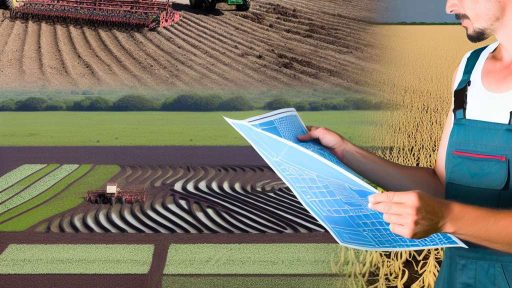Introduction to Financial Analysis in Agriculture
Financial analysis is crucial for farmers today.
It helps them understand their financial status.
This understanding directly affects decision-making.
Moreover, financial analysis equips farmers with insights into profitability.
Additionally, it informs about operational efficiency.
Farmers can track revenue and expenses systematically.
Doing so enables better resource management.
Many tools and techniques are available for analysis.
Each tool serves unique purposes and functions.
For instance, budgeting tools help plan for the future.
They assist in setting financial goals with clarity.
Similarly, financial statements reveal overall farm performance.
Farmers can analyze trends and patterns over time.
Thus, financial analysis fosters informed strategic planning.
With better insights, farmers can invest wisely.
Transform Your Agribusiness
Unlock your farm's potential with expert advice tailored to your needs. Get actionable steps that drive real results.
Get StartedSafe investments enhance growth and sustainability.
In summary, financial analysis is pivotal for agricultural success.
It allows farmers to adapt and thrive in a changing market.
Utilizing the right tools can make a significant difference.
Farmers should embrace these analytical methods for better results.
The Importance of Financial Analysis Tools for Farmers
Understanding Financial Management
Financial management is crucial for every farmer’s success.
It helps in making informed decisions about investments.
Furthermore, it supports the effective allocation of resources.
Good financial practices promote sustainable farming operations.
Enhancing Profitability
Utilizing financial analysis tools can significantly enhance profitability.
They enable farmers to track income and expenses accurately.
Consequently, farmers can identify which products yield the highest returns.
Improving profitability ensures long-term viability in the competitive market.
Risk Management
Financial analysis tools are instrumental in risk management.
They help farmers assess financial risks associated with various decisions.
By analyzing trends, farmers can forecast potential downturns.
This proactive approach reduces the impact of adverse events.
Benchmarking Against Industry Standards
Farmers can benefit from benchmarking their performance against industry standards.
Financial analysis tools provide the necessary data for comparisons.
These insights reveal areas of improvement or concern.
Ultimately, this process enhances competitiveness in the marketplace.
Facilitating Access to Credit
Access to credit is vital for expanding agricultural operations.
Financial analysis tools prepare farmers for engaging with lenders.
They present a clear picture of financial health and productivity.
Showcase Your Farming Business
Publish your professional farming services profile on our blog for a one-time fee of $200 and reach a dedicated audience of farmers and agribusiness owners.
Publish Your ProfileThis transparency builds trust with financial institutions.
Enabling Strategic Planning
Financial analysis contributes to effective strategic planning.
Farmers can set realistic goals based on solid financial data.
This data-driven approach aids in creating actionable business plans.
As a result, farmers can focus on activities that drive growth.
Key Financial Metrics Every Farmer Should Monitor
Understanding Profitability
Profitability is a crucial financial metric for farmers.
It measures the ability to generate income relative to expenses.
Farmers should regularly calculate gross and net profit margins.
A healthy net profit margin indicates a successful farming operation.
Focus on reducing costs while maximizing revenues for better profitability.
Evaluating Cash Flow
Cash flow is essential for daily operations on a farm.
This metric tracks incoming and outgoing cash over time.
Positive cash flow enables farmers to meet immediate financial obligations.
Farmers should prepare cash flow statements periodically.
This will help identify periods of surplus and deficit.
Monitoring Debt Levels
Debt levels indicate a farm’s financial stability.
A low debt-to-equity ratio suggests sound financial health.
Farmers should aim to keep debt manageable.
Regularly assess loan terms and repayment schedules.
Consider refinancing options if necessary to reduce costs.
Assessing Return on Investment
Return on investment (ROI) measures the efficiency of investments.
Farmers should calculate ROI for major purchases, like equipment.
A high ROI indicates effective utilization of resources.
This metric helps in prioritizing future investments wisely.
Improving ROI is crucial for long-term financial success.
Tracking Operational Efficiency
Operational efficiency reflects how well resources are used.
Farmers can track efficiencies using metrics like yield per acre.
Higher yields with lower input costs indicate better efficiency.
Regular evaluations can highlight areas for improvement.
Adopting new technologies can enhance operational efficiency.
Benchmarking against Industry Standards
Benchmarking helps farmers compare their performance to peers.
Identify key performance indicators within the industry.
Farmers can use industry reports for useful comparisons.
Understanding where they stand can reveal growth opportunities.
Staying informed about trends keeps farmers competitive.
See Related Content: Pricing Models To Maximize Revenue In Agritourism Offerings
Overview of Software Tools for Financial Analysis
The Importance of Financial Analysis Tools
Financial analysis tools play a crucial role in farming success.
They help farmers make informed decisions about their finances.
These tools streamline budget management and expense tracking.
Moreover, they enhance profitability analysis and cash flow forecasting.
Showcase Your Farming Business
Publish your professional farming services profile on our blog for a one-time fee of $200 and reach a dedicated audience of farmers and agribusiness owners.
Publish Your ProfileTypes of Financial Analysis Tools
Various software options are available to farmers today.
Accounting software tracks income and expenses efficiently.
Farm management software integrates accounting with production planning.
Budgeting tools assist in preparing and managing operational budgets.
Additionally, financial forecasting tools predict future revenues.
Key Features to Consider
Choosing the right tools requires evaluating their key features.
User-friendly interfaces make navigation intuitive.
Integration capabilities with existing systems streamline processes.
Data analysis features provide insights into performance metrics.
Consultation support ensures users maximize the tools’ potential.
Popular Financial Analysis Tools
Several renowned financial analysis tools cater to farmers’ needs.
QuickBooks offers comprehensive accounting solutions.
AgLeader is popular for its farm management functionality.
FarmBooks provides a specialized platform for agricultural accounting.
Moreover, ProfitCents delivers robust financial analysis and reporting.
Benefits of Using Financial Analysis Tools
Utilizing financial analysis tools enhances farm productivity.
They improve decision-making through better data insights.
Additionally, they save time by automating routine financial tasks.
Farmers can monitor their financial health more effectively.
Ultimately, these tools lead to higher profitability and sustainability.
Discover More: Water Conservation Techniques to Enhance Farm Sustainability
Utilizing Budgeting Tools for Crop and Livestock Management
The Importance of Budgeting in Agriculture
Budgeting provides farmers with a clear financial roadmap.
It enables effective allocation of resources.
Moreover, it helps in forecasting future financial performance.
Key Budgeting Tools for Farmers
Farm accounting software is essential for managing finances.
Programs like QuickBooks or FreshBooks streamline bookkeeping tasks.
Additionally, spreadsheet applications work well for creating customized budgets.
Creating a Crop Budget
A crop budget outlines expected income and costs.
It allows farmers to plan for planting and harvesting efficiently.
Moreover, it helps in determining the feasibility of specific crops.
Consider using scenarios to analyze potential price fluctuations.
- Estimate costs for seeds, fertilizer, and labor.
- Project revenue based on market prices.
- Adjust your budget according to weather forecasts.
Developing a Livestock Budget
A livestock budget encompasses various factors like feed and veterinary care.
Calculate expenses for breeding, feeding, and maintenance.
It’s imperative to account for potential health risks and their costs.
Furthermore, evaluate the market conditions for livestock sales.
- Include costs for housing and equipment.
- Factor in transportation costs for moving livestock.
- Analyze costs associated with different breeds or species.
Utilizing Budgeting Analysis for Decision Making
Regularly reviewing budget performance is crucial for success.
This practice helps identify deviations from the plan.
It allows for timely adjustments to operations and investments.
Use budgeting reports to make informed decisions.
Implementing budgeting analysis improves overall farm management.
Showcase Your Farming Business
Publish your professional farming services profile on our blog for a one-time fee of $200 and reach a dedicated audience of farmers and agribusiness owners.
Publish Your ProfileDelve into the Subject: Enhancing Soil Health with Diversified Farming Practices
Evaluating Profitability with Cost-Benefit Analysis Techniques
Understanding Cost-Benefit Analysis
Cost-benefit analysis (CBA) helps farmers assess financial decisions.
This technique compares the costs of an action to its benefits.
The outcome determines if an investment is worthwhile.
Farmers can use CBA for various projects and initiatives.
Identifying Costs and Benefits
First, outline all potential costs of an initiative.
Consider direct costs, such as seeds and labor.
Next, include indirect costs, like equipment maintenance.
Then identify expected benefits of the investment.
Benefits may involve increased yields and reduced waste.
Quantifying Financial Impacts
Once identified, quantify each cost and benefit in monetary terms.
This includes estimating future cash flows from the project.
Use historical data to improve estimates where possible.
Accuracy is crucial in this step to inform decisions.
Calculating Net Present Value
Net present value (NPV) is a key performance indicator.
It measures the profitability of an investment over time.
To calculate NPV, discount future cash flows to present value.
The formula is NPV = (cash inflow) – (cash outflow).
A positive NPV indicates a good investment opportunity.
Making Informed Decisions
With all data analyzed, make an informed decision.
Consider whether the potential benefits outweigh the costs.
Additionally, assess risks associated with the investment.
Utilizing CBA effectively can lead to improved profitability.
See Related Content: Diversifying Farm Operations with Aquaculture Integration

Using Forecasting Tools to Predict Future Financial Scenarios
Importance of Financial Forecasting
Financial forecasting helps farmers plan for the future.
It allows them to make informed decisions.
Moreover, understanding cash flow predictions enhances business strategies.
Types of Forecasting Tools
Several tools exist to aid farmers in financial forecasting.
Spreadsheet software is a common choice among farmers.
These programs can model various financial scenarios.
Additionally, specialized agricultural software offers tailored solutions.
Utilizing Historical Data
Past performance is crucial for accurate forecasting.
Farmers should analyze historical sales and expense data.
Furthermore, trends in commodity prices impact future projections.
Scenario Analysis
Scenario analysis allows farmers to evaluate different outcomes.
They can assess best-case, worst-case, and most likely scenarios.
This method fosters strategic planning and risk management.
Engaging Stakeholders
Collaborating with key stakeholders enhances forecasting accuracy.
Engage with financial advisors and crop consultants.
Their insights can provide valuable perspectives on market trends.
Showcase Your Farming Business
Publish your professional farming services profile on our blog for a one-time fee of $200 and reach a dedicated audience of farmers and agribusiness owners.
Publish Your ProfileContinuous Improvement
Farmers should regularly update their forecasting methods.
Incorporating new data leads to more accurate predictions.
Moreover, adapting to changes in the agricultural market is essential.
Assessing Financial Risks and Developing Mitigation Strategies
Identifying Financial Risks
Farmers face various financial risks in their operations.
Market volatility poses significant challenges to revenue stability.
Weather events can disrupt production and increase costs.
Additionally, fluctuating input prices affect overall profitability.
Understanding these risks is crucial for effective planning.
Analyzing Risk Exposure
Conducting a thorough risk assessment helps farmers gauge vulnerability.
Farmers should examine historical performance data for trends.
Identifying patterns allows for better prediction of future risks.
Moreover, modeling potential scenarios aids in understanding impacts.
Developing Mitigation Strategies
Farmers can implement several strategies to mitigate financial risks.
Diversifying crops can reduce reliance on a single revenue stream.
Building strong relationships with suppliers and buyers fosters stability.
Moreover, securing insurance can protect against unpredictable events.
Utilizing Financial Analysis Tools
Various financial analysis tools are available to assist farmers.
Cash flow projections help manage daily operations effectively.
Budgeting software aids in planning and tracking expenses.
Additionally, leverage risk assessment platforms for informed decision-making.
Monitoring and Adjusting Strategies
Regularly reviewing financial performance is essential for success.
Farmers should adjust strategies based on changing conditions.
Continuous monitoring allows for timely responses to emerging risks.
Finally, fostering a proactive mindset prepares farmers for uncertainties.
Integrating Financial Analysis Tools for Long-term Success
Importance of Financial Tools
Utilizing financial analysis tools is essential for farmers.
These tools can streamline operations and enhance decision-making.
Farmers can better manage resources and maximize profits.
Furthermore, they help in identifying cost-saving opportunities.
Types of Financial Analysis Tools
Several types of tools are available in today’s market.
Budgeting software allows for accurate financial forecasting.
Investment analysis tools evaluate potential returns on investment.
Accounting software simplifies financial record keeping.
Record-keeping tools assist in tracking expenses and income.
Integrating Tools for Effective Management
Integrating multiple financial tools can provide comprehensive insights.
For instance, combining budgeting software with investment analysis enhances accuracy.
This integration promotes informed decision-making and strategic planning.
Ultimately, it leads to improved financial health and sustainability.
Continuous Assessment and Adjustment
Farmers should regularly assess their financial tools’ effectiveness.
This process ensures tools meet ongoing agricultural challenges.
Furthermore, adjustments may be necessary to adapt to market changes.
Showcase Your Farming Business
Publish your professional farming services profile on our blog for a one-time fee of $200 and reach a dedicated audience of farmers and agribusiness owners.
Publish Your ProfileContinual monitoring supports long-term success and profitability.
Seeking Professional Advice
Sometimes, consulting financial professionals can be beneficial.
Experts can help select the most suitable tools for specific needs.
Additionally, they provide guidance on best practices and strategies.
This collaboration fosters a stronger financial foundation for farmers.
Additional Resources
USDA Strategic Plan Fiscal Years 2022-2026
Farmers Employ Strategies To Reduce Risk of Drought Damages …




